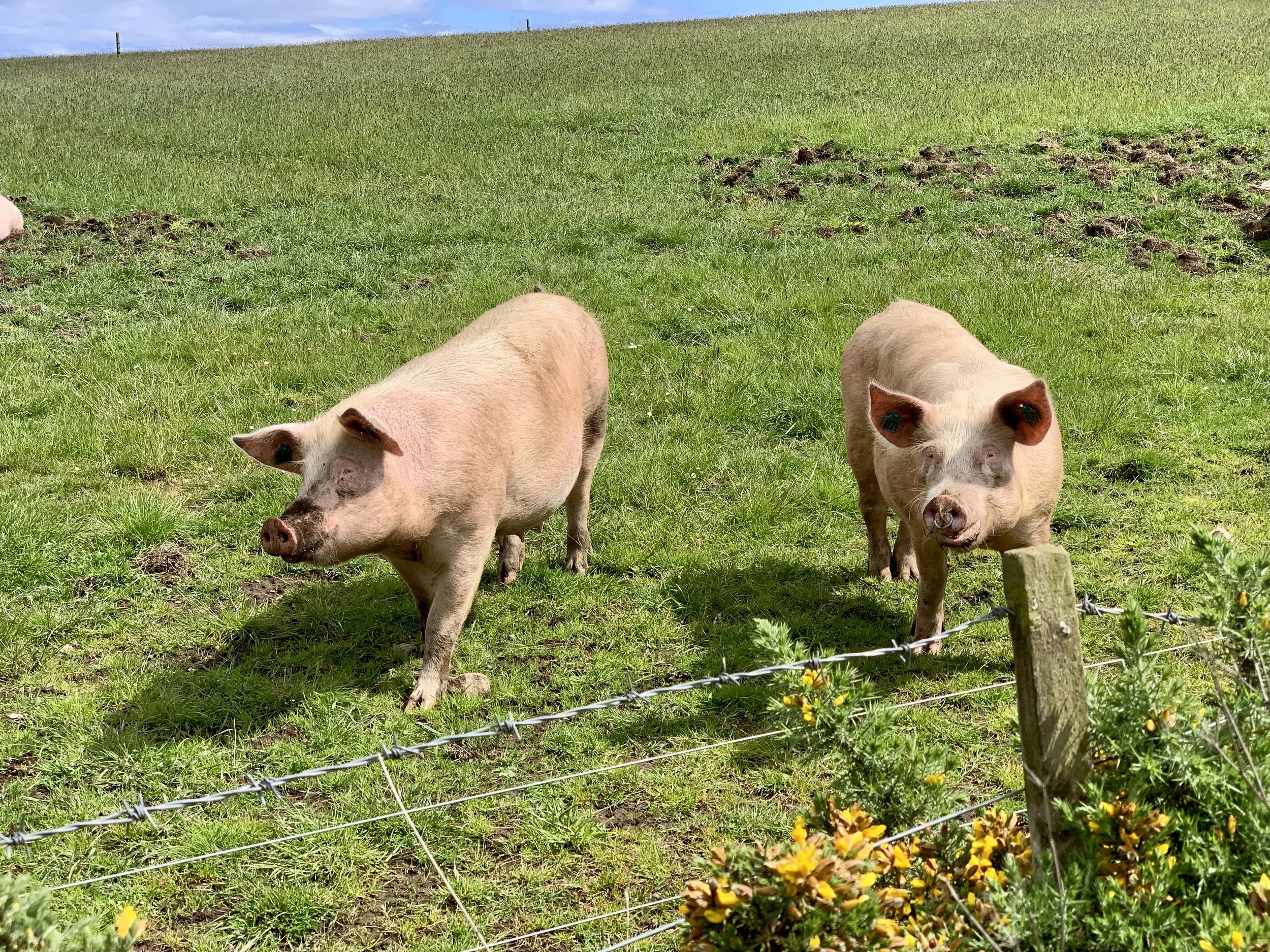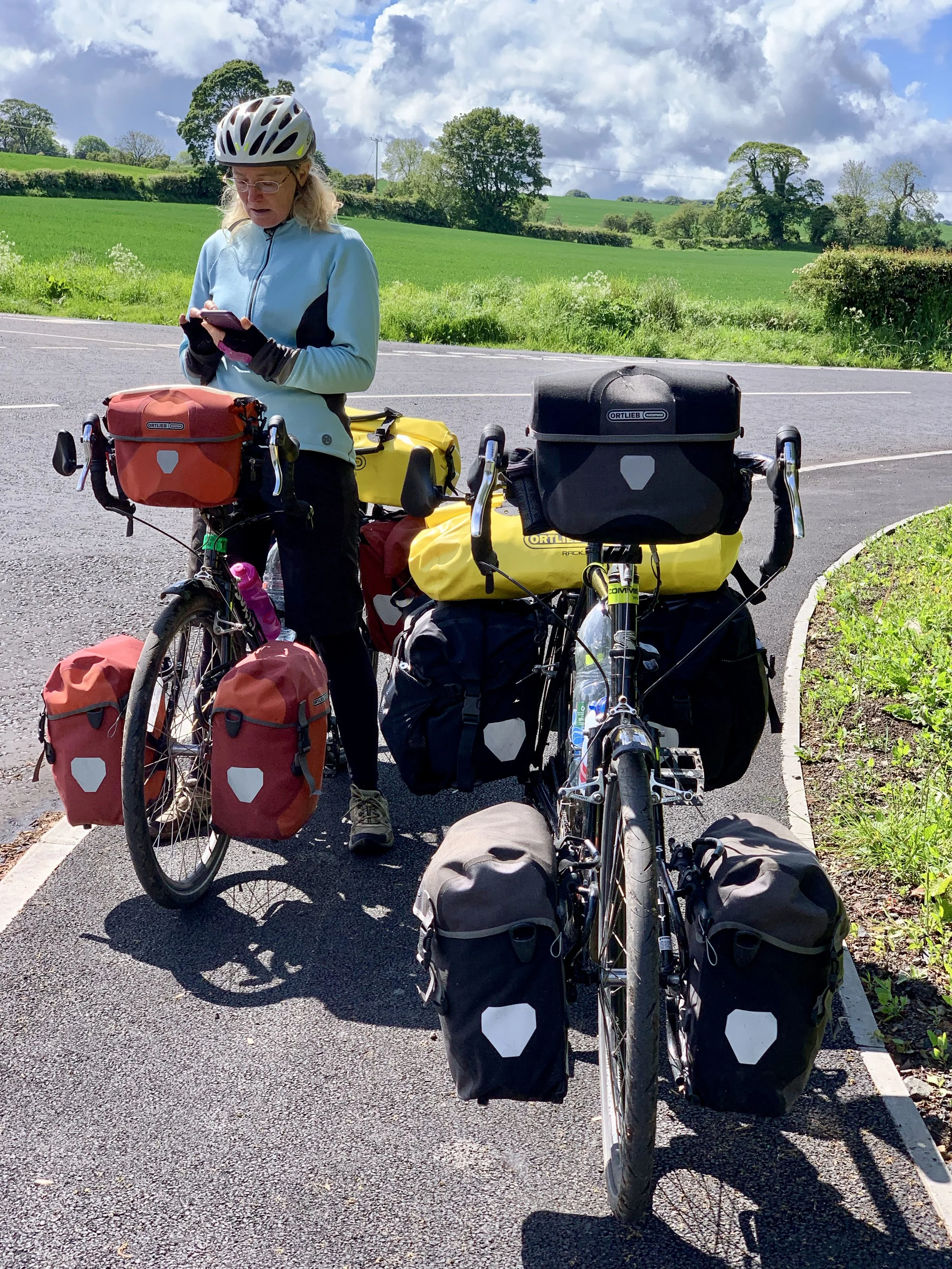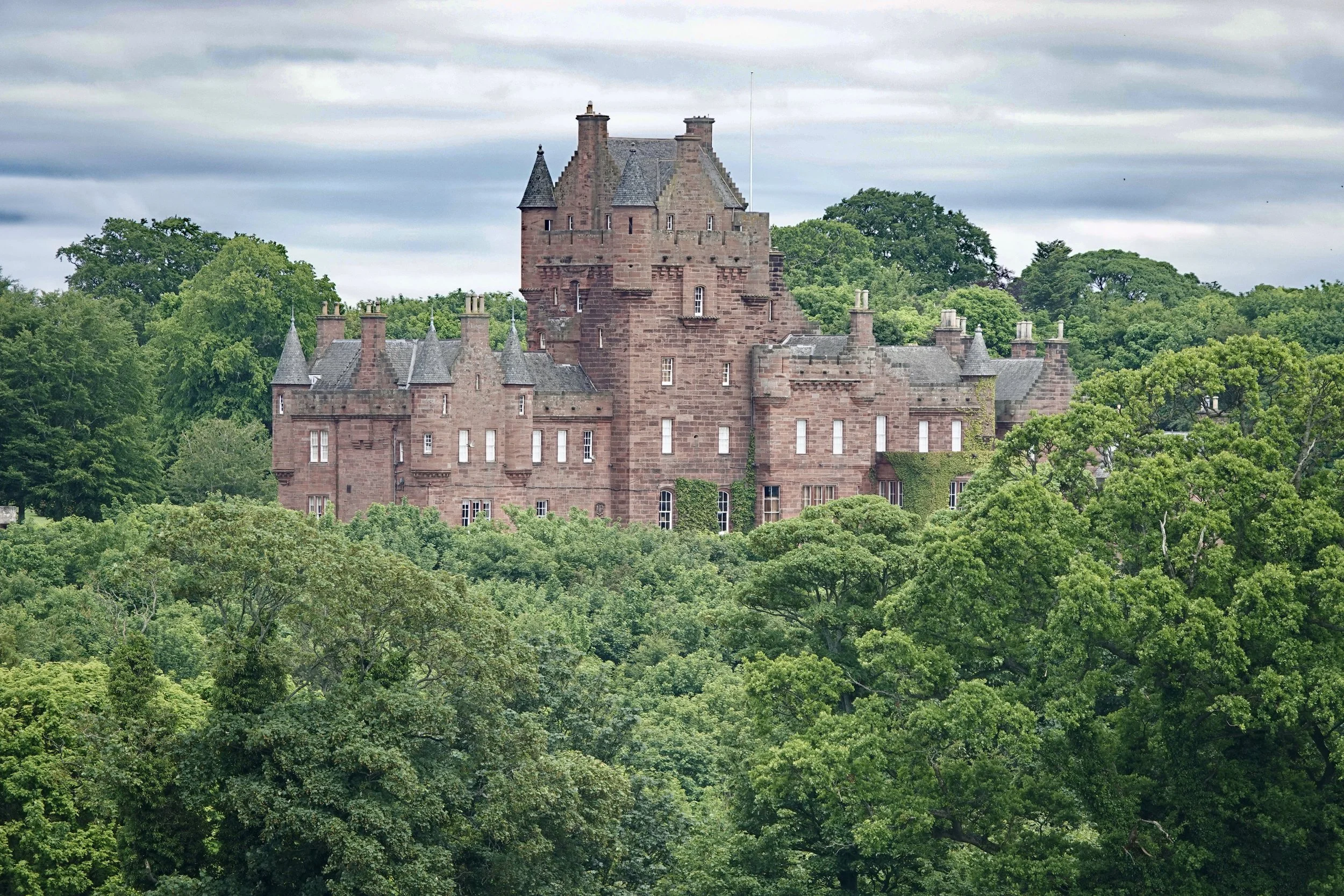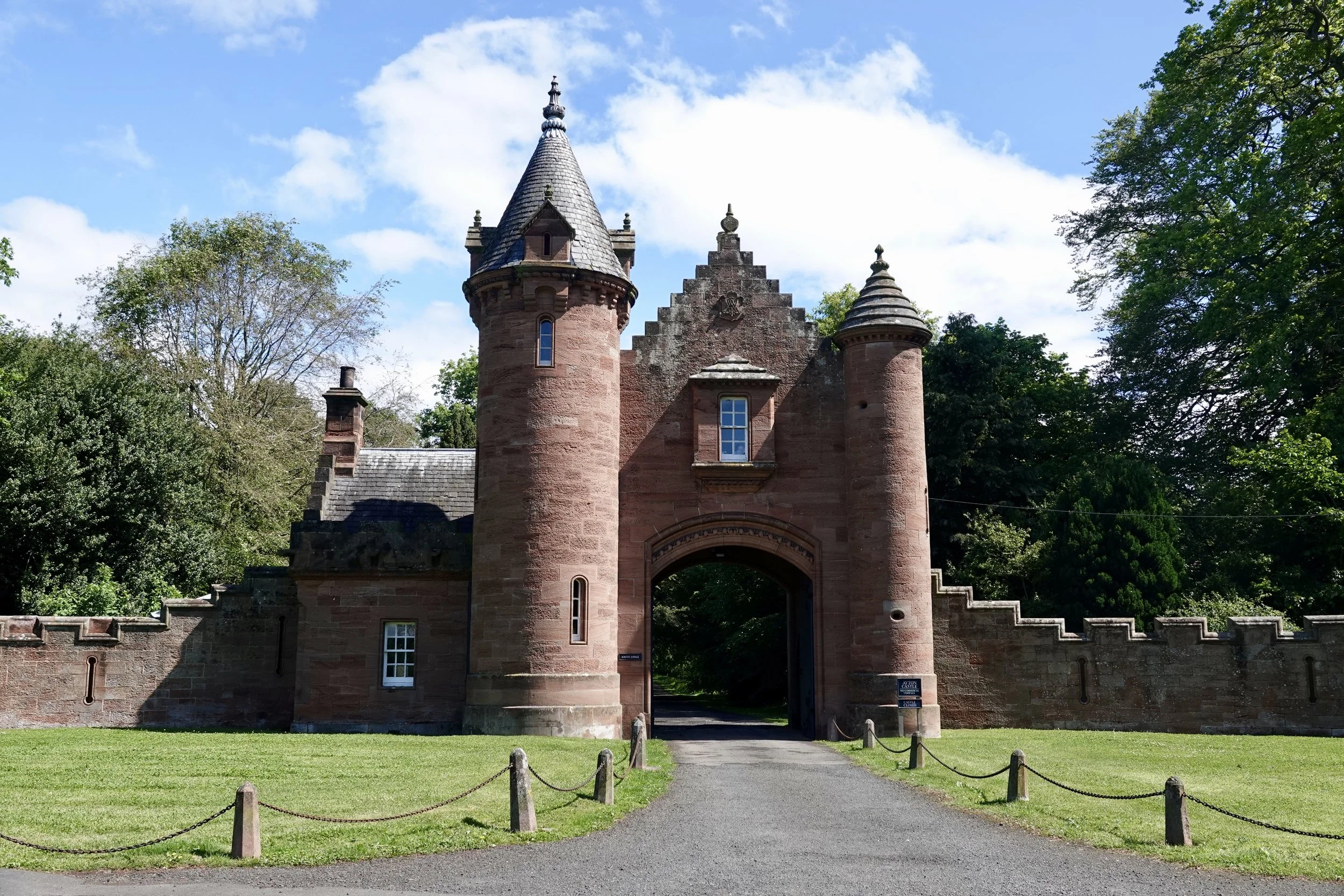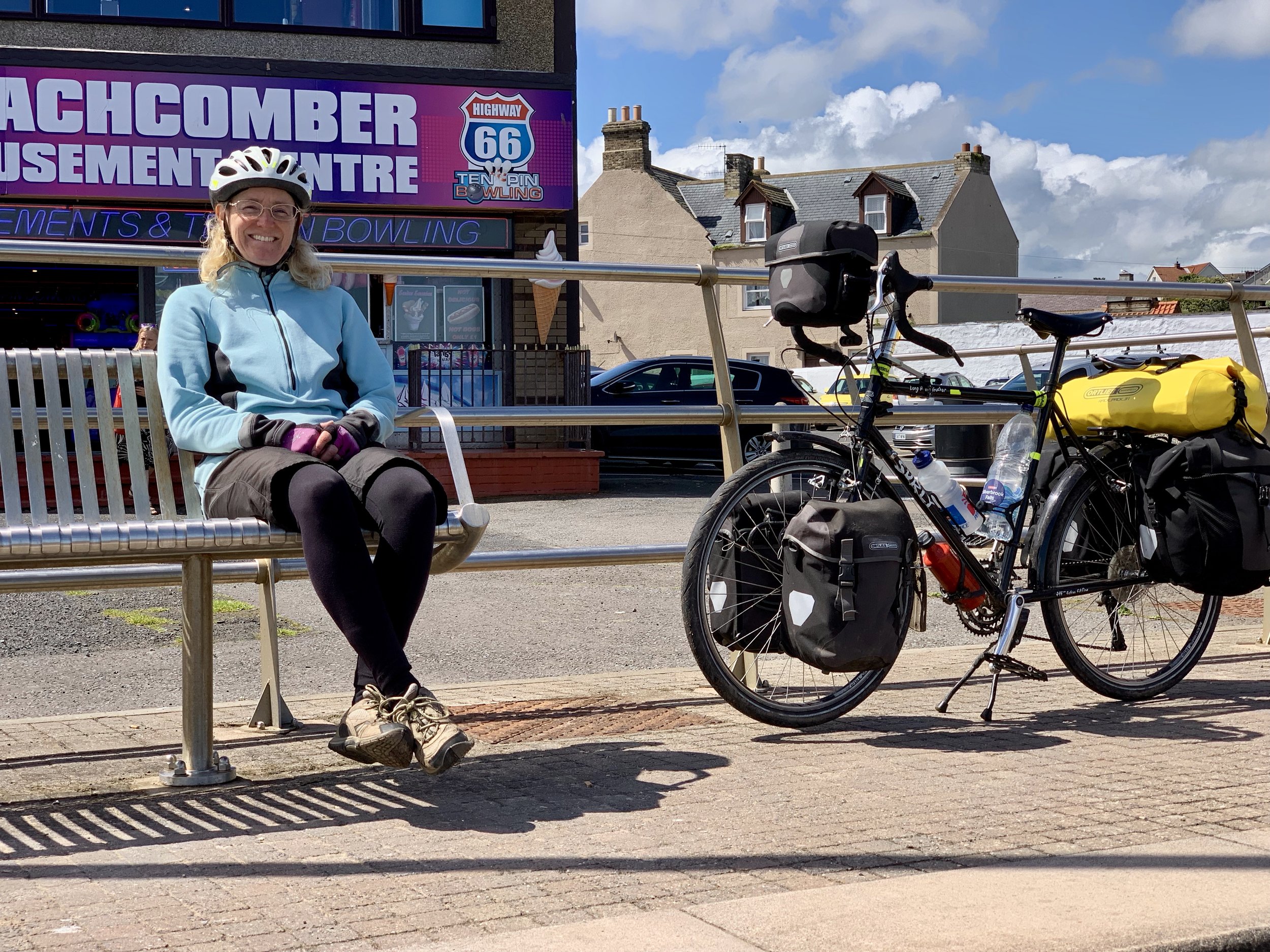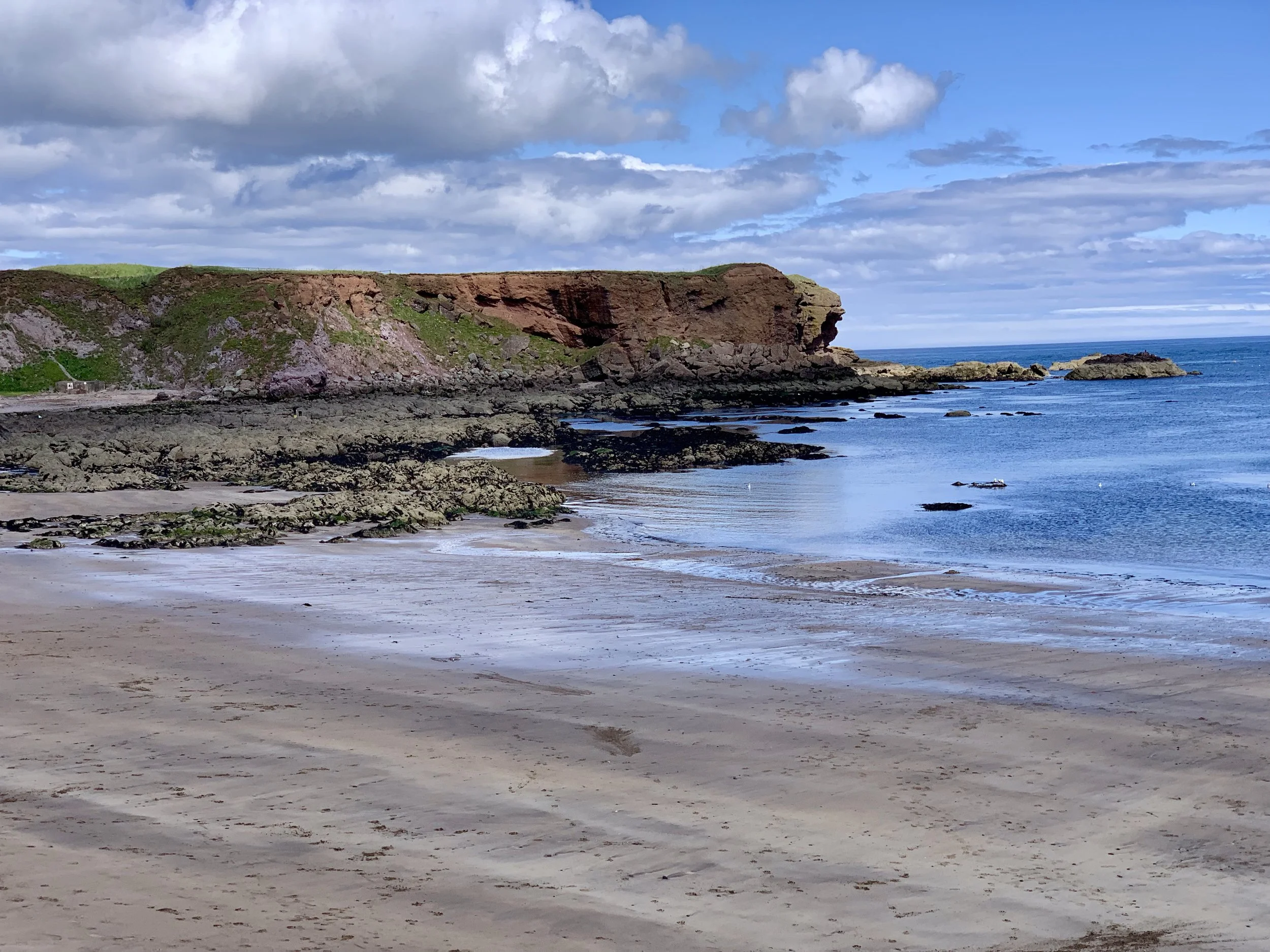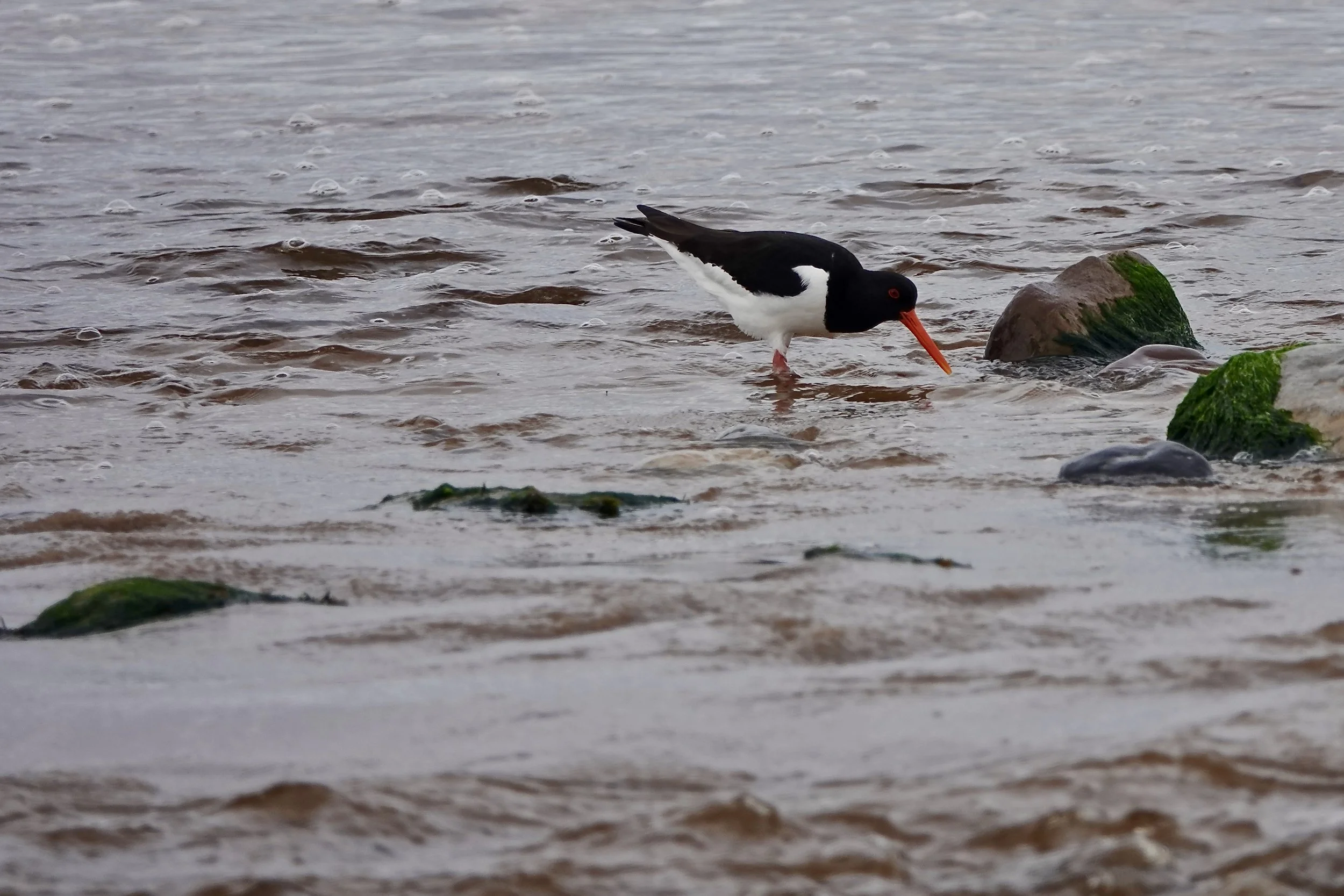Tweedmouth, UK to Edinburgh, Scotland: Cycling the Scottish Borderlands
5 - 18 June 2019
It didn’t take us long to reach Scotland. About 10 km upstream from Tweedmouth, the River Tweed forms the border between England and Scotland. As the northernmost nation that we would visit on this tour, Scotland held a special allure. We’ve finally reached the land of bagpipes, tartans, deep blue lochs, and those adorable highland cattle.
By heading almost due north since we entered Spain, we have biked just fast enough to stay a head of any uncomfortably warm weather. As spring advanced north, we advanced with it. We’ve gone back and forth between areas where the leaves were still in buds, to fully leafed out, four or five times. We’ve seen more spring flowering trees and herbaceous plants than we will likely ever see again in one year. Here in Scotland, we’re still riding comfortably in the 4-18 C range (40-65 F) - the same as it was when we left Lisbon. It’s been pretty amazing. We’ve been spoiled by such ideal cycling weather.
Tweedmouth to Thorntonloch (5 June 2019, 52.8 km, 32.8 mi)
We started by heading across the River Tweed to its north bank. The tide was high, obscuring all the mud flats we had seen yesterday evening, when we walked to the north side of the river for dinner. The high water enhanced the view upstream, by reflecting the columns of the old, stone, railway bridge.
River Tweed. Berwick-upon-Tweed, England, UK. Copyright © 2018-2019 Pedals and Puffins.
The climbing started as soon as we reached the north bank of the river, as the route turned inland to follow the Tweed upstream. We passed through Berwick-upon-Tweed’s Castle Gate, into the land beyond the city walls.
Castle Gate. Berwick-upon-Tweed, England, UK. Copyright © 2018-2019 Pedals and Puffins.
Heading up into the Scottish hills. Berwick-upon-Tweed, England, UK. Copyright © 2018-2019 Pedals and Puffins.
After about 10 km of riding steadily uphill, we arrived at the border with Scotland. Lo, and behold, there was actually a welcome sign! This is the first one we’ve encountered since entering the European Union. The crossings from Portugal, to Spain, to France and England were all unmarked. Without a welcome sign, the border crossings don’t have the same sense of accomplishment, especially since we grew accustomed to seeing signs at every state border when we biked across the U.S. last year. But given Scotland’s independent streak, we suspected that this border might be one that receives a bit more attention. We had fun posing for the official, border-crossing photo.
Welcome to Scotland! We were happy to get a welcome sign at the border. They’ve been hard to come by in Europe. Mordrington, Scotland, UK. Copyright © 2018-2019 Pedals and Puffins.
We continued on the long, smooth uphill to the top of the ridge. Once we left Berwick-upon-Tweed, the landscape became very rural. We cycled past rolling hills covered with hayfields. And we even received a warm welcome from a couple of friendly pigs.
The rolling fields of Scotland, UK. Copyright © 2018-2019 Pedals and Puffins.
The ride down into Eyemouth was very scenic because of all the hills. Along the way, we passed the Ayton Castle, which is really more of a manor house. “Castle” is kind of a squishy word. Officially, it’s the fortified residence of a noble or lord, and some say it must have a core built in the Middle Ages. But how much fortification is needed to make a house a castle? Lots of buildings that served primarily as military forts are also called castles. Ayton Castle does have a wall around it, but you’d hardly call it fortified - it’s more like a high garden wall. Apparently Ayton Castle is pretty well known in architectural circles, and is viewed as one of the best examples of the “Scottish baronial” style. It certainly cuts a striking profile, perched on a hill that is easily visible from the road.
When we reached Eyemouth, we were back on the coast, and it was time for lunch. We parked ourselves on a bench overlooking the bay, and enjoyed a fresh picnic lunch from the local Coop grocery. Every little grocery store in the UK offers something they call a meal deal, where you can choose among options for three components of the meal: a main (usually a pre-made sandwich or wrap), a snack (usually chips or fruit) and a drink. All for £3.00-£3.50. It’s a great deal, given that some of the drinks cost over two pounds when purchased separately. We’ve become regular consumers of meal deals.
The rest of the ride ambled along through a completely rural landscape, with no real towns along the way. At the top of the second ridge, a line of wind turbines reminded us that we’re biking through one of the windiest parts of Europe, not that we’d forget.
For one last, little adventure, we had a steep descent into Pease Bay, and an equally steep climb out. At the bottom of the narrow valley, the road crossed the Pease Burn by fording the stream. But with all the recent rain, the water was running pretty high, and it looked slippery. Too risky to cross with our bikes. Instead, we had to haul the bikes across a pedestrian bridge with steep stairs on both sides. At least we’ve gotten a bit more efficient in maneuvering over these bridges. We didn’t even have to remove the panniers.
That’s Pease Bay, and we’re about to plummet over this cliff to get there. Cockburnspath, Scotland, UK. Copyright © 2018-2019 Pedals and Puffins.
Pease Bay wasn’t the only narrow valley. Just up the road in Dunglass, we crossed an even narrower gorge at the Dunglass Burn. It was very lovely, especially since a bridge crossed the valley, saving us the trouble of another steep down-and-up.
View into Dunglass Burn Gorge, from the wonderful bridge that crosses it. Dunglass, Scotland, UK. Copyright © 2018-2019 Pedals and Puffins.
Our campground in Thorntonloch is on a little patch of lawn, right next to the beach. Rabbits are extremely common here. There are six in the field/parking area right next to where we’re camping, plus five more out by the road, plus more than a dozen hopping around among the mobile homes that occupy the rest of the campground. We even saw a few of the little guys venture out onto the sand of the beach. That’s a first.
We went for an evening walk on the beach. The tide was on its way out, and there were lots of birds feeding among the exposed rocks and tidal pools.
Walking along the beach, Thorntonloch, Scotland, UK. Copyright © 2018-2019 Pedals and Puffins.
Adjacent to the campground there’s a really big nuclear power plant, where they’ve built a public trail that runs along the power plant’s sea wall. While we were walking along the trail, two police officers in a vehicle stopped to talk to us. They mentioned that there were Peregrine Falcons nesting on the building, and that because of the warm water being discharged into the ocean, fish would congregate here, attracting dolphins and otters. We didn’t see any of those. But we did see some fishermen out on the rocks, hoping to catch some of the same fish.
Fishermen at the warm water outlet from the Thorntonloch Nuclear Power Plant. Thorntonloch, Scotland, UK. Copyright © 2018-2019 Pedals and Puffins.
Thorntonloch to Prestonpans (6 June 2019, 49.7 km, 31 mi)
All six rabbits were up and feeding in the field next to us when we got up and out of the tent this morning.
We’re getting closer to Edinburgh, so today we passed through more towns. One of these, Dunbar, is the birthplace of John Muir. He’s known as one of the most influential founders of the conservation movement in the U.S. He wrote passionately about the importance of nature as a place for people to find solace, and the need to protect wild places. Among his many accomplishments, he helped to secure protection for Yosemite National Park.
John Muir’s birthplace. Dunbar, Scotland, UK. Copyright © 2018-2019 Pedals and Puffins.
We visited the house where John Muir was born. The exhibits were nicely done, drawing connections between his youth in Scotland and his later conservation work in the U.S. One of the museum’s hosts was a very enthusiastic gentleman, who talked us through a great overview of John Muir’s early life, and his reasons for emigrating to the U.S. We later learned that he had written a couple of “wee books” (short books) about various aspects of John Muir’s life.
For the next 35 km, we were on, or close to, the John Muir Way, a 215 km (130 mi) route that links Muir’s birthplace in Dunbar with Scotland’s first national park, Loch Lomond. From the trail, we could see across the large estuary and bay at the mouth of the River Forth. The estuary is charmingly known as the Firth of Forth (firth is the Scottish word for estuary).
Setting out on the John Muir Way. Dunbar, Scotland, UK. Copyright © 2018-2019 Pedals and Puffins.
Mute Swans with cygnets. West Barns, Scotland, UK. Copyright © 2018-2019 Pedals and Puffins.
Up in the hills, on a tiny back road, we happened upon the ruins of Hailes Castle. This is where we first encountered the “Mary Queen of Scots slept here” phenomenon. As with George Washington in the USA, many of the places she visited during her eventful life have historical markers. Hailes Castle was the residence of James Hepburn who, in 1567, kidnapped Mary Queen of Scots and forced her to agree to marry him. On their way to Edinburgh to be married, they spent a night at Hailes Castle. Not long after that, their world fell apart. She was forced to abdicate the throne, and James fled into exile. Not a happy ending. The castle has been a ruin since 1670, when it was dismantled by Oliver Cromwell’s army.
Poppies are in full bloom. Scotland, UK. Copyright © 2018-2019 Pedals and Puffins.
After dinner, we headed over to the Prestongrange Museum, which is next to the campground where we stayed. The museum was closed, but they had quite a few outdoor exhibits about the industries that occupied the site for hundreds of years. This area was good for industry because of the very close proximity of a number of important natural materials: coal, sand (silica), salt, and clay. The major industries were coal mining, pottery, glass making, and bricks. You can still see one of the old kilns used to make the bricks, and machinery used in the coal mine.
The stroll around the grounds of the Presongrange Museum provided for a relaxing way to spend the evening. To top it off, we also got some great looks at Bullfinches - a species that has eluded us so far. We saw several pairs of Bullfinches feeding in the grass. They are very handsome birds.
Bullfinch at Prestongrange Museum. Prestonpans, Scotland, UK. Copyright © 2018-2019 Pedals and Puffins.
Back at the campsite, it was still quite light as we got ready for bed. It’s amazing how much daylight there is around here. Sunrise is at 4:30am, and sunset is at 10:20pm. But it gets light much earlier, and stays light much later, with twilight periods that can last over an hour. So there are only about four hours of true darkness. All the hotels have darkening shades or shutters that help keep out that extra sunlight when you’re trying to sleep. It’s kind of hard to believe, but right now we’re a little bit farther north than Polar Bear Provincial Park on Hudson Bay in Ontario. Thank goodness for the warm Gulf Stream.
Prestonpans to Edinburgh (7 June 2019, 14.7 km, 9 mi)
We planned a very short day for today, with riding time of only about 1.5 hrs. It was good that we had some extra time, because my front tire was flat in the morning. While changing the tire, we pulled out a thorn that didn’t seem to go all the way through the tire. We weren’t sure if that was the culprit, but we couldn’t find any other sharp objects. So we changed the tube and hoped for the best.
We had nice views along the Firth of Forth, as we headed towards Edinburgh.
Mute Swans and seagulls in the Firth of Forth. Scotland, UK. Copyright © 2018-2019 Pedals and Puffins.
The ride to our Airbnb was almost all uphill, but mostly at a gentle grade. Some of it was even on rail trails. There were some busy sections of road, but also some very nice bike paths that appeared to be new. After we arrived the rain started, and there was light rain for the rest of the day. We felt lucky to be settled in before the rain.
Our apartment is way out, on the far, southeastern edge of the city. One of its best qualities is that it’s very quiet. It’s also spacious and fairly comfortable, but the wifi is awful. It’s slow even when it’s working. But it also goes down completely, for several hours at a time, pretty frequently.
Edinburgh Layover (8 - 18 June, 2019)
I had a couple of days in Edinburgh before I needed to head back to the United States. We used the time to take care of tasks like patching the tube from Friday’s flat tire, figuring out how to repair a shock cord in our tent poles that is wearing through, cleaning and drying out the tent.
For the second time on this trip, we went through all our stuff and decided to send about 3.25 lbs more stuff home. I’ll be carrying these things back to the U.S., where I will mail them to a very sweet relative who will hold onto them for us while we’re gone. One item going home is Puffer our mascot. He’s turned out to be a bit camera-shy, especially in wind and rain. He’s happy to have seen the puffins at Bempton Cliffs, and is ready to end his tour. Other things going back are extra pairs of cycling gloves, shorts, a shirt, a couple of collapsible bottles, our silk sleeping bag liners (hardly used at all), some electronics cables, my old prescription glasses, and a coarse water filter. That will lighten our loads.
PedalingGuy’s new kickstand has been coming loose a lot, so he decided to change the bolt that holds it onto the bike. There was a high risk it was getting stripped. When we removed the old bolt, we discovered it was bent! That takes a lot of force. It’s a good thing he decided to replace it now, before it bent any further. He might not have been able to remove it in the future.
Our bikes put a lot of stress on their tripod kickstands. This bolt secured PedalingGuy’s kickstand onto his bike. Good thing he replaced it. Edinburgh, Scotland, UK. Copyright © 2018-2019 Pedals and Puffins.
Fixing the shock cord on the tent poles turned out to be a lot easer than we first expected. After doing some research, we decided that the shock cord didn’t need to be replaced, yet. Instead, we performed minor surgery by tying off the section that was damaged. The procedure went well, and it looks like the current shock cord will last for a while longer.
With all that done, I set off for the U.S., to teach a class in nonprofit management, hosted by the Ecological Society of America.
While I was away. PedalingGuy completed the first two dental appointments of five that are required. The first appointment was a consultation, but the second one initiated the root canal procedures. Everything has gone as well as can be expected, so far. Overall, PedalingGuy has been very happy with the quality of the dental care here in Scotland. In fact, he thinks it’s a lot better than he was getting back home.
The dental office that PedalingGuy is visiting in Scotland is pretty close to the Edinburgh Castle, which sits high on a bluff overlooking the city. Edinburgh, Scotland, UK. Copyright © 2018-2019 Pedals and Puffins.
After a week away, I was eager to get back to Scotland to continue the bike trip. In a couple of days, we’ll be back on the road.
Somewhere above Ireland, on the flight back to Scotland from the U.S. Copyright © 2018-2019 Pedals and Puffins.

